Thank you to Natasha Møller for allowing us to use Kumlegaard for the photoshoot.
Location link: https://kumlegaard.dk
Sources:
https://www.fundis-reitsport.de/blog/ausbildung/springgymnastik-winterarbeit/
Jumping exercises are great training for horses to improve strength and balance, no matter the height. Poles and cavaletti can be integrated in any horse`s training. Practicing the correct time to takeoff and evaluating the distance towards the jump is not easy to learn. Being able to regulate the length of a canter stride as well as consistent rhythm are important. Especially poles or cavaletti are a considerable tool to work on the rhythm in trot and canter. Furthermore, adjusting the distance between them can be used to practice shortening or extending canter strides.
Moreover, it can be helpful to count the strides out loud and have help from a trainer or someone adjusting the distance during the training. To improve the rider’s and horse’s response time and quickness, trot poles can be added as part of the course to include transitions. This also facilitates thoroughness and suppleness of your horse.
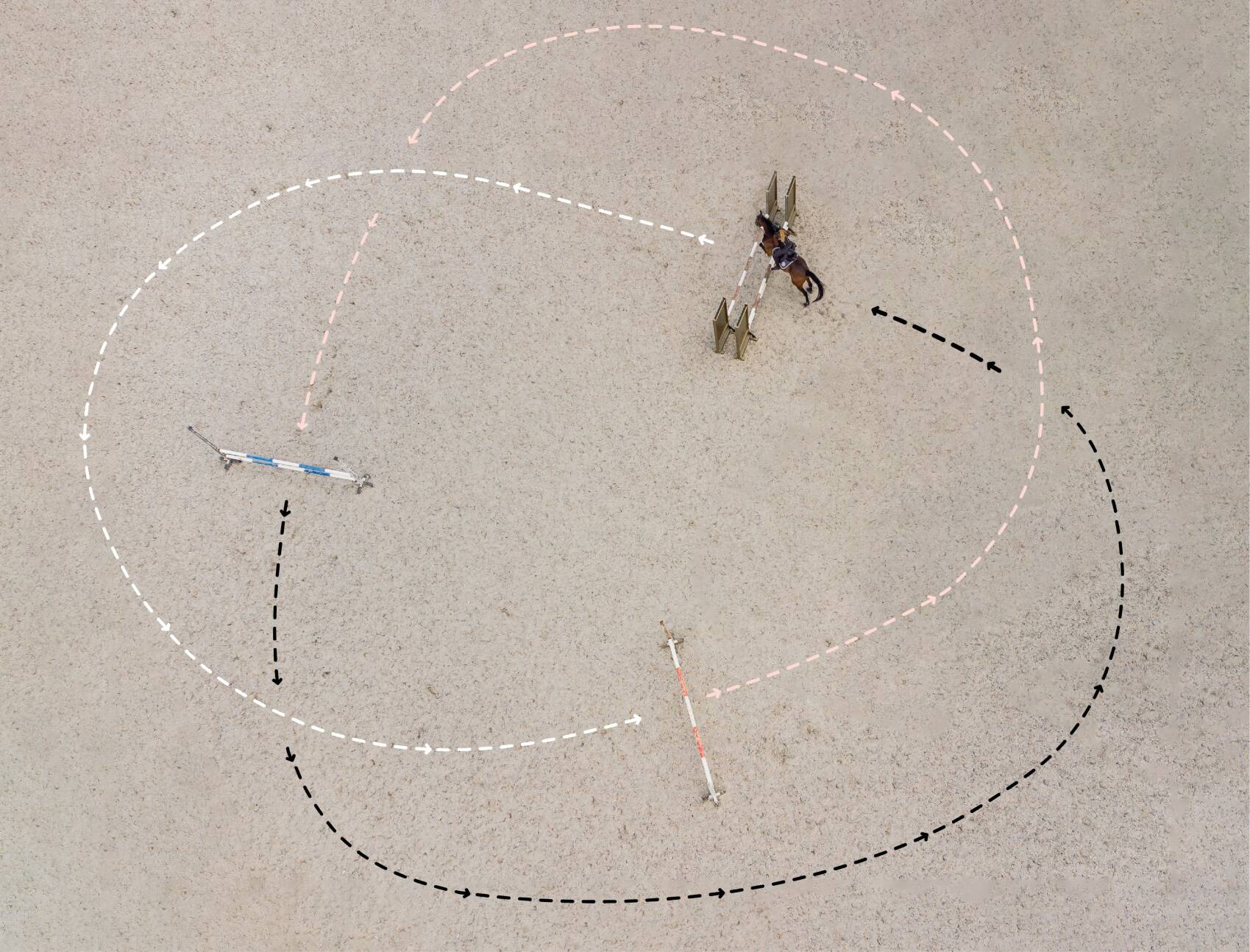
Three jumps on a circle
Requirements for this exercise:
For this exercise, the rider and horse should be able to canter on a consistent circle and jump on a curved line. There are only three jumps, and the trainer or rider decides whether to use single jumps, oxers or a mix. The jumps are arranged in a circle, either a little displaced or all on the same line.
Different difficulty levels:
Adjust the height of the jumps to the riding level. The size of the circle also influences the difficulty level, the smaller the circle, the harder it gets. While cantering on the circle the rider will now take every second jump and pass outside of the jump that is left out. This requires the horse to listen carefully to the signals from
the rider and concentrate on the task. The exercise should be done on the left and right rein. Start with lower jumps and raise them if it feels easy.
Practice outcome:
This exercise is great to coordinate the horse around the jumps, especially if it is a little fresh and pulls towards them. If it does not feel right to make a jump, it is always possible to skip one and take the next jump again without making your horse feel like it ran past it, because it is part of the exercise to switch between taking and passing the jumps. In a show jumping course there might be jumps on a curved line or after a circle, and this is a good way to practice it.
Distances
These distances are, and remember that every horse is individual, and distances vary with the height of the jumps. The average canter stride of a horse is 3.60 meters and 3 meters for a pony. The following distances are between the jumps, giving the horse enough space to land and takeoff.
Horse:
1 stride = 7.10m - 8.00m
2 strides = 10.30m - 11.00m
3 strides = 14m - 15m
Pony:
1 stride = 7.00m - 7.50m
2 strides = 9.80m - 10.30m
3 strides = 13.20m - 14.20m
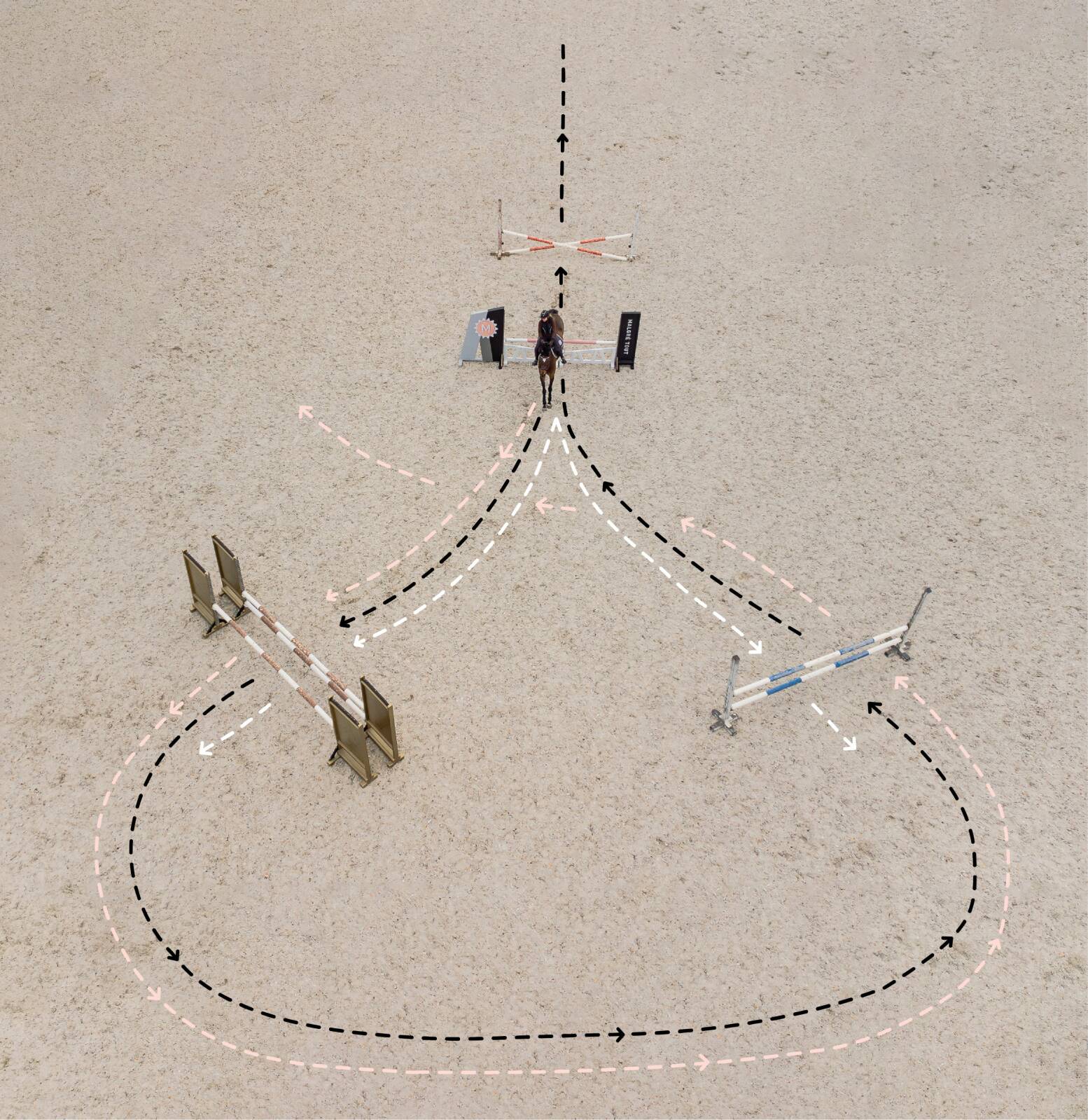
Jumps on a straight and diagonal line
Requirements for this exercise:
This set-up is a mix of a straight line of jumps paired with a curved line towards the last jump. At least three jumps are needed for this exercise, but an idea is to add cavaletti in the beginning or poles in between. A possible set up is a cavaletti and a cross as a bounce, continued by a jump with a canter stride in between. Those jumps are put on the center line between A and C, followed by a jump on each side towards the right and left, which can be a vertical or an oxer. We recommend having at least two or three canter strides towards the last jump to get the right angle.
Different difficulty levels:
Take all straight jumps down the center line, then proceed to the jump left or right. Start over and take the other side this time.
Take the straight jumps, then proceed to the jump on the right side. Continue in a left-handed circle and take the left jump from the oppposite side. Do the exercise the other way around, taking the left jump and then the right one from the opposite side.
Take all straight jumps, then proceed over the jump on the right side. Continue to the left in a circle and take the left jump and all the way back over the straight jumps down the center line. Do the exercise the other way around, taking the left jump first and continue to the right.
Practice outcome:
This exercise trains coordination and reaction. It will train your eye for the jumps and help you plan the perfect line for the best takeoff. It is a good way to get many different approaches out of a single set up.
Bounces & gymnastics
Requirements for this exercise:
This exercise consists of a row of jumps placed close together, without space for one canter stride in between the jumps. Therefore, the horse moves directly from one jump to the other. At least three jumps or cavaletti make a gymnastic line, but more can be added or a mix of both. Different difficulty levels: Putting two to three cavaletti, poles or small cross jumps in a straight row is a good start, if the exercise is new to the horse. If this feels easy, the difficulty level can be advanced by adding more jumps, raising the jumps or arranging them on a curved line.
Different difficulty levels:
Putting two to three cavaletti, poles or small cross jumps in a straight row is a good start, if the exercise is new to the horse. If this feels easy, the difficulty level can be advanced by adding more jumps, raising the jumps or arranging them on a curved line.
Practice outcome:
Not every horse does well with this exercise, some tend to speed up too much. If the horse is running too fast whilst training the gymnastic line, it can help to widen the distance between the jumps and place poles between them to create a rhythm. Stopping between the jumps may help getting a hot horse to slow down and focus on the rider again.
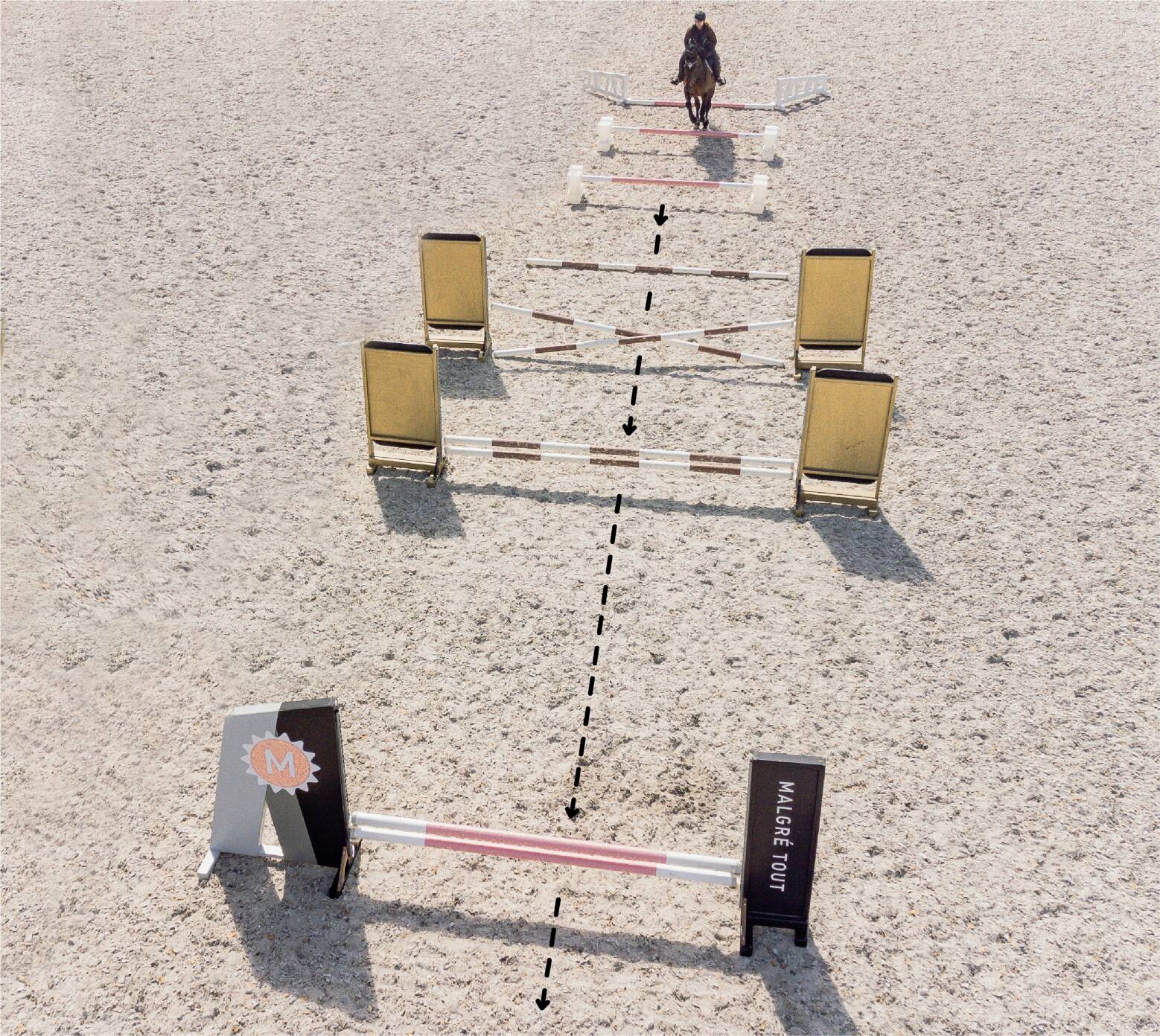
Practicing jump exercises can be an excellent help for horse and rider to work on balance, strength, coordination, rhythm, and trust. In this article you can find inspiration for your own training with the following three exercises, which can be adjusted to different levels.
S mall jumps and cavaletti are an effective way to gymnasticate the horse and improve the rider´s seat, which is beneficial for all riders, not only show jumpers. Training with poles and jumps is activating certain muscles in the back and hindquarters of the horse, that are usually not used during other training. Hence, it is a fantastic way to challenge the horse´s body and build physical strength, as well as exercising the mind. Training with multiple jumps or poles in a row, for example a bounce grid, is a great way to test or improve the reaction time and skills of the rider, as well as the horse’s coordination, and the rhythm of the canter.
By Silja Springfeld. Photos: Malgré Tout // Trine Bjørn Puggaard

Jumping exercises are great training for horses to improve strength and balance, no matter the height. Poles and cavaletti can be integrated in any horse`s training. Practicing the correct time to takeoff and evaluating the distance towards the jump is not easy to learn. Being able to regulate the length of a canter stride as well as consistent rhythm are important. Especially poles or cavaletti are a considerable tool to work on the rhythm in trot and canter. Furthermore, adjusting the distance between them can be used to practice shortening or extending canter strides.
Moreover, it can be helpful to count the strides out loud and have help from a trainer or someone adjusting the distance during the training. To improve the rider’s and horse’s response time and quickness, trot poles can be added as part of the course to include transitions. This also facilitates thoroughness and suppleness of your horse.
Thank you to Natasha Møller for allowing us to use Kumlegaard for the photoshoot.
Location link: https://kumlegaard.dk
Sources:
https://www.fundis-reitsport.de/blog/ausbildung/springgymnastik-winterarbeit/
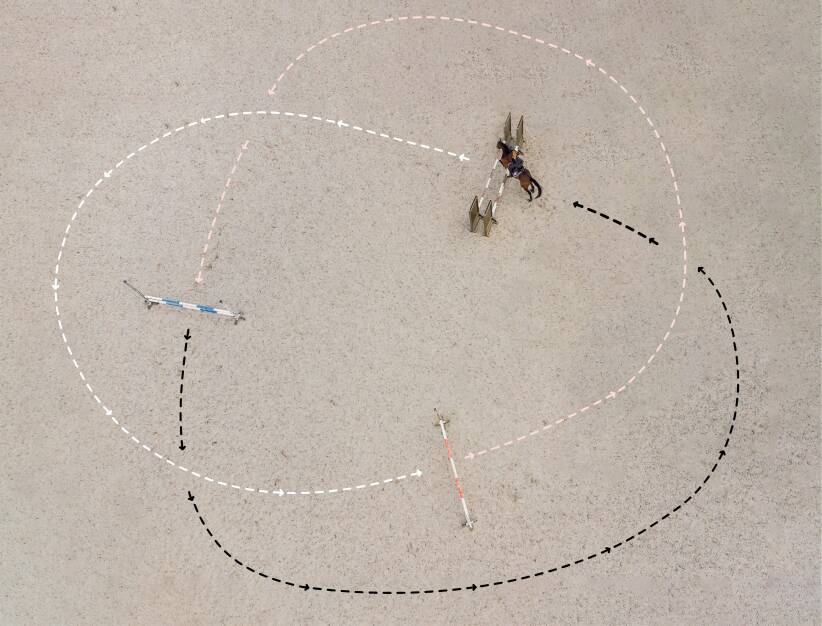
Three jumps on a circle
Requirements for this exercise:
For this exercise, the rider and horse should be able to canter on a consistent circle and jump on a curved line. There are only three jumps, and the trainer or rider decides whether to use single jumps, oxers or a mix. The jumps are arranged in a circle, either a little displaced or all on the same line.
Different difficulty levels:
Adjust the height of the jumps to the riding level. The size of the circle also influences the difficulty level, the smaller the circle, the harder it gets. While cantering on the circle the rider will now take every second jump and pass outside of the jump that is left out. This requires the horse to listen carefully to the signals from
the rider and concentrate on the task. The exercise should be done on the left and right rein. Start with lower jumps and raise them if it feels easy.
Practice outcome:
This exercise is great to coordinate the horse around the jumps, especially if it is a little fresh and pulls towards them. If it does not feel right to make a jump, it is always possible to skip one and take the next jump again without making your horse feel like it ran past it, because it is part of the exercise to switch between taking and passing the jumps. In a show jumping course there might be jumps on a curved line or after a circle, and this is a good way to practice it.
Distances
These distances are, and remember that every horse is individual, and distances vary with the height of the jumps. The average canter stride of a horse is 3.60 meters and 3 meters for a pony. The following distances are between the jumps, giving the horse enough space to land and takeoff.
Horse:
1 stride = 7.10m - 8.00m
2 strides = 10.30m - 11.00m
3 strides = 14m - 15m
Pony:
1 stride = 7.00m - 7.50m
2 strides = 9.80m - 10.30m
3 strides = 13.20m - 14.20m
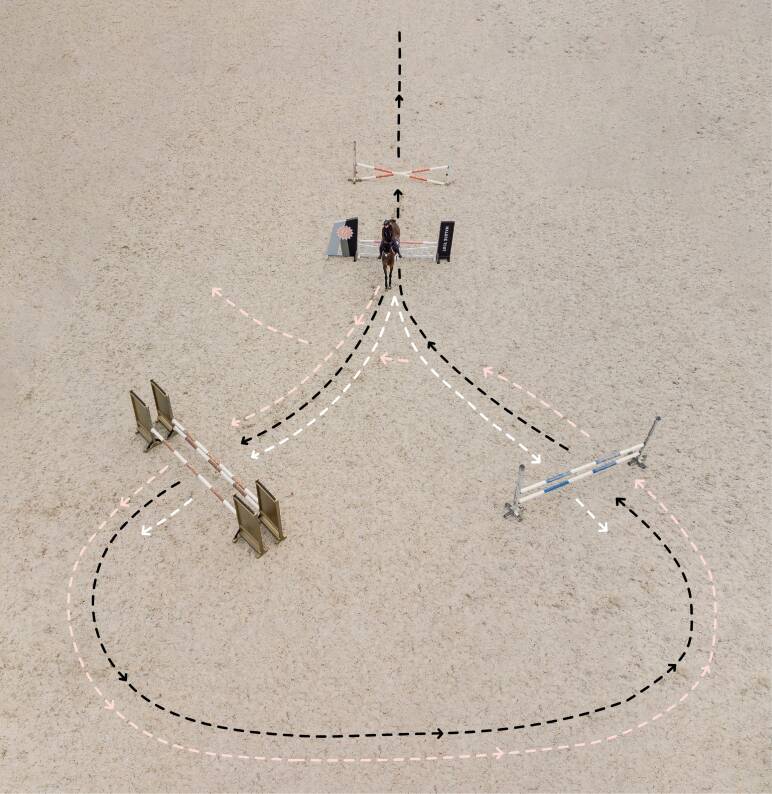
Jumps on a straight and diagonal line
Requirements for this exercise:
This set-up is a mix of a straight line of jumps paired with a curved line towards the last jump. At least three jumps are needed for this exercise, but an idea is to add cavaletti in the beginning or poles in between. A possible set up is a cavaletti and a cross as a bounce, continued by a jump with a canter stride in between. Those jumps are put on the center line between A and C, followed by a jump on each side towards the right and left, which can be a vertical or an oxer. We recommend having at least two or three canter strides towards the last jump to get the right angle.
Different difficulty levels:
Take all straight jumps down the center line, then proceed to the jump left or right. Start over and take the other side this time.
Take the straight jumps, then proceed to the jump on the right side. Continue in a left-handed circle and take the left jump from the opposite side. Do the exercise the other way around, taking the left jump and then the right one from the opposite side.
Take all straight jumps, then proceed over the jump on the right side. Continue to the left in a circle and take the left jump and all the way back over the straight jumps down the center line. Do the exercise the other way around, taking the left jump first and continue to the right.
Practice outcome:
This exercise trains coordination and reaction. It will train your eye for the jumps and help you plan the perfect line for the best takeoff. It is a good way to get many different approaches out of a single set up.
Bounces & gymnastics
Requirements for this exercise:
This exercise consists of a row of jumps placed close together, without space for one canter stride in between the jumps. Therefore, the horse moves directly from one jump to the other. At least three jumps or cavaletti make a gymnastic line, but more can be added or a mix of both. Different difficulty levels: Putting two to three cavaletti, poles or small cross jumps in a straight row is a good start, if the exercise is new to the horse. If this feels easy, the difficulty level can be advanced by adding more jumps, raising the jumps or arranging them on a curved line.
Different difficulty levels:
Putting two to three cavaletti, poles or small cross jumps in a straight row is a good start, if the exercise is new to the horse. If this feels easy, the difficulty level can be advanced by adding more jumps, raising the jumps or arranging them on a curved line.
Practice outcome:
Not every horse does well with this exercise, some tend to speed up too much. If the horse is running too fast whilst training the gymnastic line, it can help to widen the distance between the jumps and place poles between them to create a rhythm. Stopping between the jumps may help getting a hot horse to slow down and focus on the rider again.

Practicing jump exercises can be an excellent help for horse and rider to work on balance, strength, coordination, rhythm, and trust. In this article you can find inspiration for your own training with the following three exercises, which can be adjusted to different levels.
S mall jumps and cavaletti are an effective way to gymnasticate the horse and improve the rider´s seat, which is beneficial for all riders, not only show jumpers. Training with poles and jumps is activating certain muscles in the back and hindquarters of the horse, that are usually not used during other training. Hence, it is a fantastic way to challenge the horse´s body and build physical strength, as well as exercising the mind. Training with multiple jumps or poles in a row, for example a bounce grid, is a great way to test or improve the reaction time and skills of the rider, as well as the horse’s coordination, and the rhythm of the canter.
By Silja Springfeld. Photos: Malgré Tout // Trine Bjørn Puggaard
